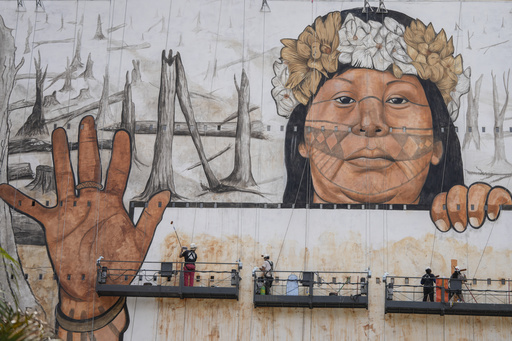
SAO PAULO — On Wednesday, Brazilian artist Mundano unveiled an enormous street mural in Sao Paulo, crafted from ash generated by wildfires and mud extracted from floods. This striking artwork aims to draw attention to the extreme weather phenomena that have been causing significant destruction throughout the country, while also addressing their underlying causes.
Measuring more than 30 meters (about 98.4 feet) in height and 48 meters (approximately 157.5 feet) in width, the mural vividly illustrates the harsh realities of deforestation and severe drought plaguing the Amazon rainforest, with images of cracked brown earth and lifeless gray tree stumps. In the center of the mural, Indigenous activist Alessandra Korap is portrayed adorned with a floral crown and holding a sign that declares: “Stop the destruction #keepyourpromise.”
This message is particularly directed at Cargill, a Minnesota-based agricultural giant. Mundano emphasizes that soy cultivation is a significant factor behind the ongoing deforestation in the Amazon. Cargill has publicly committed to eradicating deforestation from its supply chain across Brazil, Argentina, and Uruguay by the year 2025. Mundano is intent on ensuring that the company follows through on its promises.
In a recent interview, Mundano expressed the frustration felt by many: “We are tired of being a country, a continent where we and the natural resources we have here are exploited. … We have to regenerate our planet instead of destroying it.”
Recently, uncontrolled wildfires, primarily attributed to human activity, have ravaged protected regions within the Amazon, the Cerrado savanna, and the Pantanal, the world’s largest tropical wetland. These fires have released smoke that blankets extensive areas, making life difficult for residents in several cities. The situation is further exacerbated by severe drought conditions, as outlined in a report from Brazil’s disaster warning center, Cemaden, indicating that this drought may linger throughout much of the country well into the month.
Climate change, significantly driven by the combustion of fossil fuels such as oil, gas, and coal, is generating increasingly frequent and severe shifts in weather patterns.
In the Amazon, for instance, the depth of the Negro River measured 12.46 meters (41 feet) on Tuesday—up slightly from the previous record low 10 days prior, which marked the lowest level since records began 122 years ago. However, this level remains nearly 6 meters (20 feet) below what is typically expected for this time of year. Rivers in the Amazon usually fluctuate with the seasonal rains and dry periods, but the current dry season has proven to be especially severe.
Earlier this year, a daunting flood in the southern state of Rio Grande do Sul resulted in over 180 fatalities and impacted more than two million people, devastating numerous communities.
Mundano, who describes himself as an “artivist,” incorporated mud from that flood—sourced through the activist group Movement of People Affected by Dams—into his mural. He also included ash from various regions, including the Amazon, the Atlantic Forest, the Pantanal, and the Cerrado. Additionally, he collected soil discarded in dumpsters across Sao Paulo and clay from Sawre Muybu Indigenous territory in the Amazon, which is Korap’s place of origin.
“From floods to droughts, everything is connected!” Mundano emphasized in an Instagram post, showcasing a video of the mural in Sao Paulo, which he described as his largest artistic endeavor to date.
Three years prior, Mundano created a similar mural utilizing ash from the Amazon, featuring imagery of a firefighter amidst deforested land, complete with scenes of a cattle ranch and trucks laden with logs.
